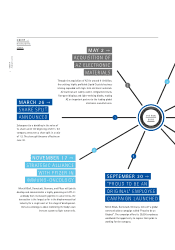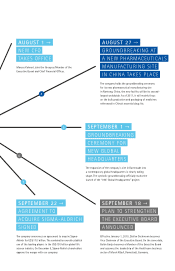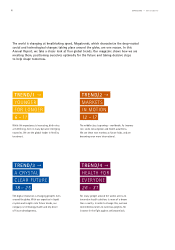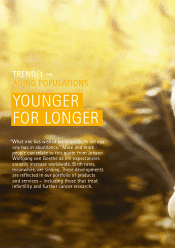Merck 2014 Annual Report Download - page 16
Download and view the complete annual report
Please find page 16 of the 2014 Merck annual report below. You can navigate through the pages in the report by either clicking on the pages listed below, or by using the keyword search tool below to find specific information within the annual report.
11MAGAZINE → Younger for Longer
infertility is not confined to western in-
dustrialized nations. However, in many
countries it is a taboo topic. For this reason,
in 2014 Merck KGaA, Darmstadt, Germany,
launched a widespread educational cam-
paign in India in order to overcome the
culturally driven obstacle of silence.
LONGER LIFE EXPECTANCY
THANKS TO MEDICAL ADVANCES
Birth rates continue to decline worldwide,
especially in highly developed societies
and in the emerging markets of Asia and
Latin America. At the same time, life
expectancy is increasing (see text on right)
with growing numbers of people who are
getting older and older. This development
is giving rise to new challenges. This
relates not only to typical age-related dis-
eases such as neurodegenerative disorders
that the medical world is aiming to fight.
Therapies to treat chronic diseases can also
help younger patients to remain active
members of the workforce and society for
longer. One of the company's goals is to
help people with neurodegenerative dis-
orders such as multiple sclerosis by offer-
ing therapies that substantially help to
improve their quality of life. The same
applies to cancer therapy. Thanks to highly
specialized biopharmaceuticals, many tu-
mors can now be cured through early
detection and treatment. And the company
continues to drive progress in cancer re-
search with new approaches that focus pri-
marily on harnessing the immune system
to fight cancer. “In the field of immuno-
oncology, we are testing treatment possi-
bilities for our anti-PD-L1 antibody in sev-
eral different pivotal clinical studies across
multiple types of cancer, including non-
small cell lung cancer and ovarian cancer,
as well as Merkel cell carcinoma, a rare
form of skin cancer,” said Luciano Rossetti,
Head of Global Research and Development
at the Group's Biopharmaceuticals busi-
ness. The broad range of innovative mate-
rials, reagents, test kits and equipment
from the Life Science business of Merck
KGaA, Darmstadt, Germany, also supports
medical progress. Diverse products make
the development and manufacture of new
medicines much easier – from filtration,
sample preparation and cell biology in-
struments, products used in oncology and
neurology, in molecular biology and stem
cell research, or for infectious diseases and
metabolic disorders.
HIGH QUALITY OF LIFE IN OLD AGE
Growing older does not necessarily mean
becoming more ill. The vast majority of
“new” senior citizens feel fitter for longer.
They are active, like to travel and con-
sume, and they take care of themselves.
The company is responding to the increas-
ingly health-conscious older population
with over-the-counter products for the
self- treatment of minor complaints. In
pharmacies around the
globe, consumers
can find products tailored
to the varying
requirements of older men and women –
for example the Seven Seas Perfect7®
range, a combination made from sources
of natural fish oil rich in omega-3 fatty
acids, with important vitamins and miner-
als. Products like these are helping a grow-
ing number of people enjoy a high quality
of life in old age. In order to maintain their
appearance, they can rely on cosmetic
active ingredients, for example substances
that offer protection from UV radiation,
combat aging of the skin and regulate the
skin’s moisture balance. If wrinkles persist,
they can be covered with a skin-colored
silicate powder.
→ Declining birth rates
In the early 1960s, the worldwide fertility
rate averaged 4.9 children per woman. In
2012, the rate had fallen to 2.6 children over-
all, and in industrialized countries to 1.6.
Women in Germany currently give birth to an
average of just 1.4 children. When the birth
rate falls below the replacement-level fertili-
ty rate of 2.1 children per woman, population
numbers shrink. In a global comparison, the
African continent has the highest fertility
rate of 4.4 children per woman.
→ Life expectancy and world population
are rising
Recent UN studies show that the world pop-
ulation will grow from the current 7 billion
to 11 billion people by the year 2100. Africa’s
population will show a particularly dynamic
development. It is likely to increase between
now and then from 1 billion to 4 billion peo-
ple. Increasing life expectancy is the main
driver of population growth worldwide. In
1900, life expectancy in Germany was ap-
proximately 45 years; today a girl born in
Germany can expect to live to the age of 83,
and a boy to the age of 78. Researchers
believe life expectancies around the world
will continue to increase at varying rates,
depending on the region.
LUCIANO ROSSETTI →
EXECUTIVE VICE PRESIDENT,
GLOBAL HEAD OF RESEARCH &
DEVELOPMENT AT THE
BIOPHARMACEUTICALS BUSINESS
























